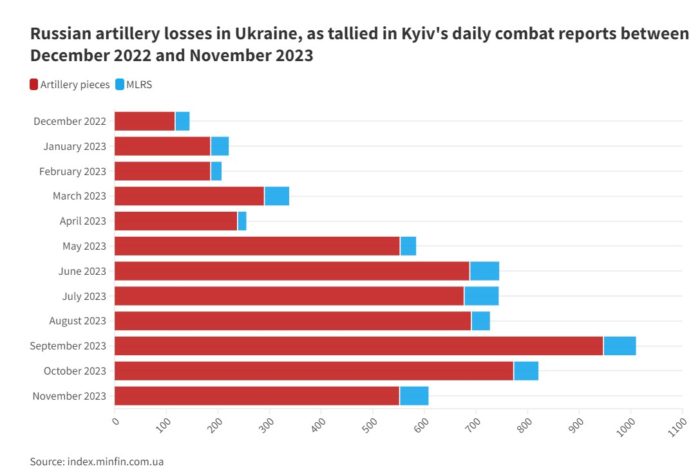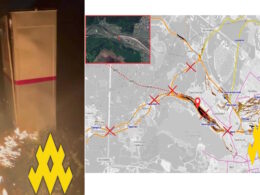The losses of Russia's artillery in Ukraine have significantly depleted the offensive potential of the Russian army in Ukraine, according to Newsweek.
Intensive artillery fire has dominated the battlefields in Ukraine since day one of the full-scale Russian invasion. Russia's military doctrine has retained its historic focus on artillery. In the early stages of the full-scale Russian invasion of Ukraine, Russian artillerymen were more numerous and well-supplied than Ukrainian artillerymen.
However, the Russian artillery was suppressed as NATO artillery systems reinforced Ukraine's arsenal. Soaring Russian equipment losses demonstrate the effectiveness of Ukrainian artillery and drone teams, which are hunting down Russian large-caliber guns and multiple-launch rocket systems (MLRS).
From September to November 2023, Ukraine destroyed 2,272 artillery pieces and another 167 MLRS, according to the data of the General Staff of Ukraine's Armed Forces. For the same period in 2022, Russia lost 789 artillery systems and 108 MLRS during its invasion of Ukraine, according to Ukraine's General Staff.

Credit: Newsweek.
Ivan Stupak, a former officer of the Security Service of Ukraine (SBU) and current advisor to the Ukrainian parliament's National Security Committee, told Newsweek that Russian artillery losses are indeed a massive blow to the Russian army.
"It's really a big problem for the Russians. It's not just a cliché. It's not Ukrainian propaganda. For the last five months or so, Russia has very actively been using old-style artillery. Not late-Soviet era, but mid-50s and mid-60s—D30 and the D20-type of towed artillery, with a maximum range of around 14 to 18 kilometers (9 to 11 miles)," Ivan Stupak said. "It's a very short distance; it's nothing compared with the Archer [modern Swedish-made self-propelled howitzer - ed.]," Stupak added, referring to the artillery system donated to Ukraine by Sweden, which has a range of more than 45 kilometers (around 28 miles).
According to Ivan Stupak, Russian artillery stockpiles "are completely depleted. Outdated Soviet-era artillery systems of the Russian army cannot compete with NATO systems that Ukraine has in terms of precision and range, Ivan Stupak noted. Furthermore, Ukraine's artillerymen effectively use sophisticated Western-supplied counter-battery radars to locate firing Russian guns quickly.
Russian President Putin is putting the economy on a military footing, but ramping up production of artillery spare parts is challenging and partly depends on Western technology, to which Russia currently has limited access. According to Ivan Stupak, the pressure of worn-out barrels is "a particularly big issue" for the Russian military-industrial complex.
At the same time, Ukraine has "a lot of problems" with the supply of artillery ammunition from European countries, Stupak told Newsweek.
"We [Ukraine - ed.] were promised about one million artillery shells, but up to now we've got only about 300,000," Stupak said.
While Ukraine runs out of ammunition for its artillery systems, Russia has received a million shells from North Korea and Iran, Newsweek noted.
On the other hand, the Russian army has a hard time dealing with Western-supplied cluster munitions of the Ukrainian Armed Forces. The uptick in claimed destroyed Russian guns coincided with the arrival of cluster munitions, which spread hundreds of bomblets over a target area rather than relying on a single shell, Newsweek noted.
Apart from standard cluster munitions, Ukraine also uses HIMARS-fired longer-range cluster munition variants of MGM-140 Army Tactical Missile System (also known as the ATACMS missiles).
Dan Rice, a former aide to Ukraine's Commander-in-Chief General Valerii Zaluzhnyi, told Newsweek that the Ukrainian Armed Forces have "fire superiority" over the Russians and more advanced and effective weapons systems.
"The full-scale deployment of cluster artillery shells and rockets has entered a new phase in the war, which is why Putin is suggesting peace talks and calling it a 'tragedy," Dan Rice said.
According to Dan Rice, Russia is grappling with "deep strikes against large troop concentrations and any Russian artillery or MLRS that fires."
Related:
- ISW: Iran supplies Russia with glide bombs
- EU commissioner advocates for redirecting 40% of EU ammo exports to fulfill Ukraine's million-round need
- Borrell: EU could achieve 1 mn artillery goal for Ukraine by redirecting exports
- EU will not supply 1mn rounds to Ukraine by March, foreign minister confirms
- Frontline report: Ukrainian advances in Kherson Oblast create a tactical dilemma for Russian military





